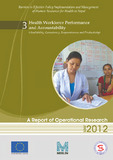Please use this identifier to cite or link to this item:
https://hdl.handle.net/20.500.14356/726| Title: | Health Workforce Performance and Accountability |
| Authors: | European Union MERLIN SOLID/Nepal |
| Citation: | Society for Local Integrated Development Nepal (SOLID Nepal) and Merlin Nepal. Barriers to Effective Policy Implementation and Management of Human Resources for Health in Nepal: Health Workforce Performance and Accountability (Availability, Competencies, Responsiveness and Productivity). Lalitpur, Nepal: SOLID Nepal; 2012 |
| Issue Date: | May-2012 |
| Publisher: | SOLID Nepal 2012 |
| Abstract: | Introduction: The performance of health workers plays a crucial role in the improvement of health outcomes, due to its impact on accessibility to health services and appropriateness of care provided to service users. Despite its key impact on health outcomes, there is limited evidence on the performance of health workers and effective strategies in Nepal. This report therefore provides insight into health workforce performance in Nepal, looking at the four dimensions of health workforce performance: availability, competency, responsiveness and productivity. It informs policy-makers and managers on interventions to improve health workforce performance in Nepal. Methodology:A cross-sectional descriptive study was conducted using mixed method with observation checklist. Fifteen districts representing eco-developmental regions of Nepal were selected using multi-stage cluster sampling method. Out of 404 sample, 747 health workforce from 375 health institutions were interviewed (<10% non-response rate) using the Probability Proportionate to Size method as per WHO guideline. Observation was carried out in 256 health facilities. Further, secondary review was carried out for triangulation of findings.Key findings: Despite the fact that policies are in place to ensure the availability of health workers, less than half of health workers were present in their place of work and active at the time of survey. Reasons for absenteeism among HWs included deputation, training, leave and transfer. For doctors, the main reason for absence was deputation (38%), and for nurses, it was leave (23%). The situation was particularly difficult in remote rural areas particularly the western mountain regions.A common theme among service users, service providers and civil society organisations was the need to address the limited availability of health workers by building and enhancing the capacity of the primary health care staff and community health workers. At the same time staff reported a lack of training and poor resourcing of health facilities. Local governments chose to address the issue by recruiting temporary staff at the local level, predominantly from the same area. In comparison to permanent staff, the short term suitable solution does not ensure that staff are sufficiently supported with the correct salary and benefits package or career structure.Staff competency was assessed through self evaluation. A high percentage of health workers (Doctors 29.4% and HA/AHW 11.4%) felt they were unable to work to the expected standard. The main reasons were reported to be lack of training and performance management. This study has suggested that it is not only the lack of training that affects staff performance but the quality of existing training. Trained staff do not meet required competency levels and there is limited management training which has affected the quality of district and facility management. Health workers are often not provided with the job description or outdated job descriptions with poorly defined responsibilities. In addition to these constraints over half the health staff interviewed stated they had insufficient equipment and medical supplies in their facilities. This lack of support affected services that could be provided, the confidentiality of service and communication between health staff and patients. In turn this affected the sense of pride in health workers and their connection with the community. There is limited resources for communities to address shortfalls in clinical care. Accountability systems are weak; and district and village development committees have limited budgets and authority. Conclusion and Recommendations:A more effective recruitment system and greater investment in permanent positions is required, as well as a more decentralised system to support improved information on staff availability and more appropriate deployments. The training curricula needs to be revised and updated, with a greater emphasis on broader public health skills such as IMNCI and IMPAC to support primary health workers to undertake greater clinical roles in the absence of doctors in remote areas. Formal training for community health workers that enables task shifting is also crucial. A greater emphasis on health management is required, as well as. Civil Society Organisations can work with local authorities to ensure appropriate accountability and complaint systems, which are essential for ensuring improved performance in the health workforce. |
| metadata.dc.description.sponsorship: | European Union and the Ladham Trust |
| URI: | http://103.69.126.140:8080/handle/20.500.14356/726 |
| Appears in Collections: | Post Graduate Grant (PG) Reports |
Items in DSpace are protected by copyright, with all rights reserved, unless otherwise indicated.

